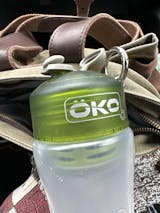
What is ÖKO?
👨👩👧👦 Une gourde filtrante réutilisable pensée pour les petits comme pour les grands.
⚡ Pressez, buvez et profitez d’une eau filtrée en un geste.
🔁 Durable et économique : seul le filtre se remplace après environ 378 L (+/- 6 mois si 2 L/jour).
🌍 Un geste simple pour la planète : moins de déchets plastiques à usage unique.

1
Une technologie inspirée par la NASA
Une innovation de 2002, au service de l’eau que vous buvez.
Issue d’un programme développé par la NASA pour filtrer l’eau de l’ISS, la technologie ÖKO combine nanofibres d’alumine et charbon actif micropoudré.
Testée par l’Institut Pasteur de Lille et de Guadeloupe (chlordécone), IANESCO et Eurofins, elle démontre une réduction significative de plus de 200 polluants : PFAS, TFA, microplastiques,métaux lourds, pesticides, résidus médicamenteux, virus et bactéries.
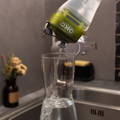
2
Une eau du robinet plus qualitative
Pour une eau plus agréable à boire au quotidien
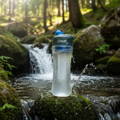
3
Filtration des eaux non potables
Une solution de confiance pour l'aventure et les voyages
En voyage, randonnée ou situation nomade, le filtre ÖKO constitue une solution fiable et immédiate pour améliorer la qualité de l’eau douce non traitée (rivières, lacs, fontaines).
Les tests en laboratoires accrédités COFRAC démontrent une réduction de 99,9993 % des bactéries (Salmonella) et jusqu’à 99,992 % des virus.
Compacte, réutilisable et robuste, la gourde ÖKO est aujourd’hui utilisée dans plus de 120 pays, avec des retours utilisateurs très positifs, notamment lors de voyages à l’étranger où elle a prouvé sa fiabilité et sa praticité.

4
Testée en laboratoires accrédités COFRAC
Une fiabilité contrôlée, selon les plus hautes exigences
Les performances des filtres ÖKO ont été vérifiées par plusieurs laboratoires accrédités COFRAC, conformément à la norme ISO/IEC 17025.
Plus de 200 composés de référence ont été analysés : PFAS, métaux lourds, microplastiques, pesticides, virus, bactéries…
Ces résultats garantissent une rigueur scientifique et une traçabilité complète des performances.
Les rapports complets sont disponibles sur la page Analyses en laboratoire.
🔍3 steps to understanding filtration🔍
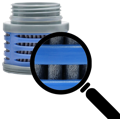
01
Filter composition
La membrane filtrante est composée d’une fibre minérale naturelle (pseudoboehmite AIOHH), d’ions antibactériens, saupoudrée microscopiquement de charbon actif.
It is 8 mm thick and has over 400 pores.
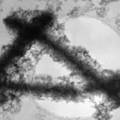
02
Mechanical filtration
Its pores are calibrated to 1.25 microns, mechanically blocking all particles equal to or larger than this size, such as sediments and impurities.
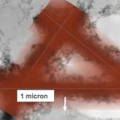
03
Submicron filtration
On contact with water, the natural mineral fiber emits a positive charge field that surrounds the hollow volume of the pores. The water is thus freed of submicronic contaminants, attracted like a magnet to the membrane's retention surface. This is electro-adsorption.
Laboratory tests

01
Virus

02
Bacteria

03
Chlorine

04
PFAS

05
TFA

06
CVM

07
Pesticides & herbicides

08
Chlorothalonil & Chlordécone

09
Heavy metals

10
Fluorine

11
Drug residues

12
Plastic
⚖️ Disclaimer officiel - Responsabilité & transparence ÖKO EUROPE
Tests accrédités : Technologie d’origine NASA (2002); Performances vérifiées par des laboratoires accrédités (COFRAC ISO/IEC 17025).
Preuve d’efficacité : Des milliers d’utilisateurs dans plus de 120 pays rapportent une utilisation efficace sur eaux naturelles et urbaines.
La gourde ÖKO est un dispositif de filtration mobile de confort, conçu pour réduire la présence mesurée de nombreux polluants testés.
Elle ne remplace pas un système de potabilisation homologué.
Fiabilité et conditions d’usage : Les performances observées dépendent toujours de la qualité initiale de l’eau et du respect des consignes d’entretien indiquées dans la notice. Conservez celle-ci et respectez l’entretien et le remplacement du filtre.
Responsabilité individuelle : Chaque utilisateur reste responsable de l’eau qu’il choisit de filtrer. ÖKO Europe ne peut contrôler ni garantir toutes les situations d’utilisation.
Tout emploi non conforme (eaux stagnantes, liquides non adaptés, manipulations risquées) ou volontairement détourné engage la responsabilité de son auteur.
Transparence totale : Tous les rapports d’analyses et protocoles de tests sont disponibles sur la page Analyses en laboratoire.
For our children and our planet
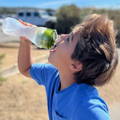
The next generation
Let's teach them the right gestures from an early age.
Thanks to ÖKO!

For our planet
Less plastic pollution. For future generations.
Thanks to ÖKO!
L'eau chargée redevient parfaitement claire
Why does ÖKO use plastic?
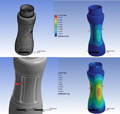
- De qualité alimentaire.
- Compressible and lightweight : thanks to this flexible material, you can easily squeeze and propel water through the filter.
- Tough and durable: designed to last for many years, withstanding both high temperatures and daily use.
- Tasteless and odourless: preserves the natural, pure taste of your water.
- At the end of its life, your water bottle body can be 100% recycled.
ÖKO EUROPE & Olympique de Marseille

Technical data
Technology
ÖKO's ultra-filtering flask combines unique alumina nanofiber technology, derived from the mineral pseudoboehmite, with mechanical filtration with medium-sized pores of 1.25 microns.
Flow
Up to 10x higher than equivalent filtration systems (2 L / min)
Material
Polypropylène (PP5) et Tritan (capuchon) de qualité alimentaire
Maintenance
The gourd, pipette and cap (without filter) can be easily washed at room temperature with soap and/or water.
NEVER clean the filter or put it in contact with anything other than water (if you have to filter muddy water: rinse the outside of the filter with water).
Bottle capacity
Disponible en version 650 mL et 1 L
Filter life
Up to 378 L (with clear, low-sediment water). The more sediment in the water, the shorter the filter life.
Weight
147 g (gourde 650 mL) / 172 g (gourde 1 L)
Dimensions
H 23,3 cm (650 mL) / H 26,5 cm (1 L)
Diameters
Ø 71 mm (650 mL) / Ø 85 mm (1 L)
Included in the water bottle
Carabiner, nozzle cap and ÖKO filter
 Contact us
Contact us
 FREE* delivery on orders over €75
FREE* delivery on orders over €75
 Delivery in 2 to 5 days
Delivery in 2 to 5 days
 Secure payment
Secure payment
 Official distributor
Official distributor

